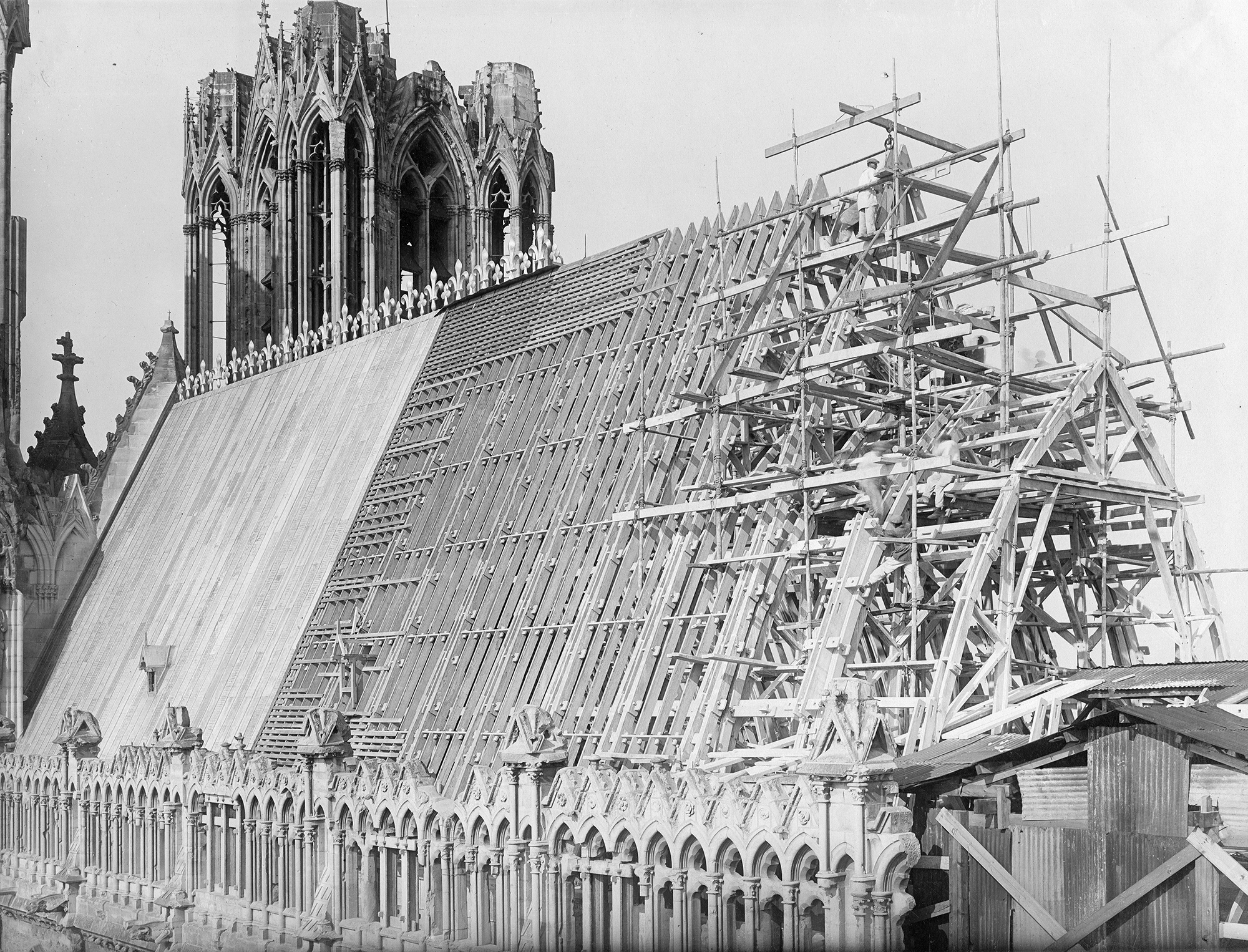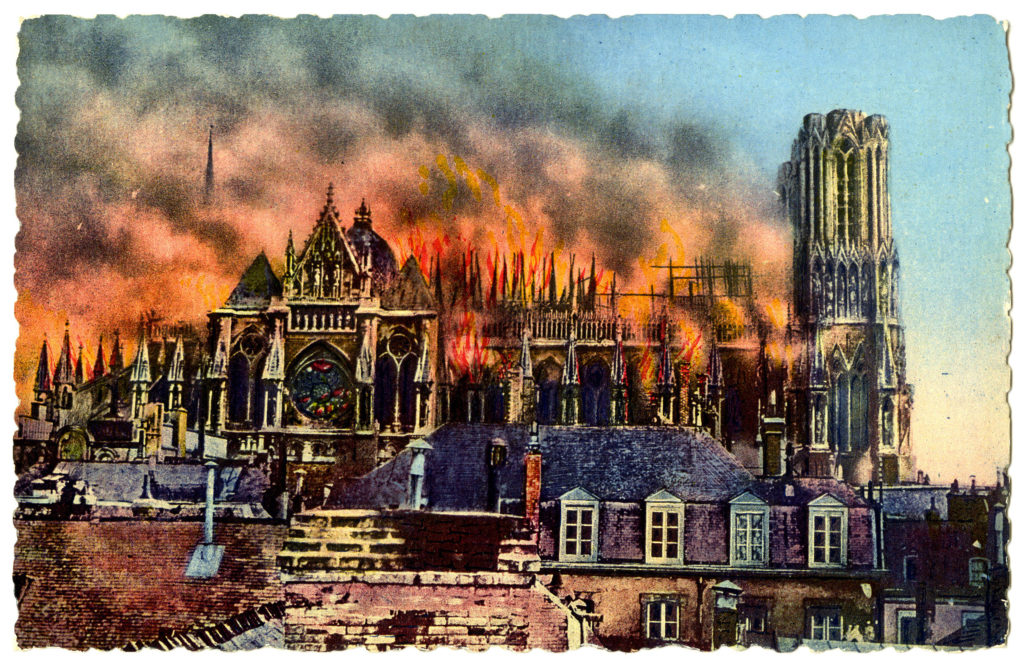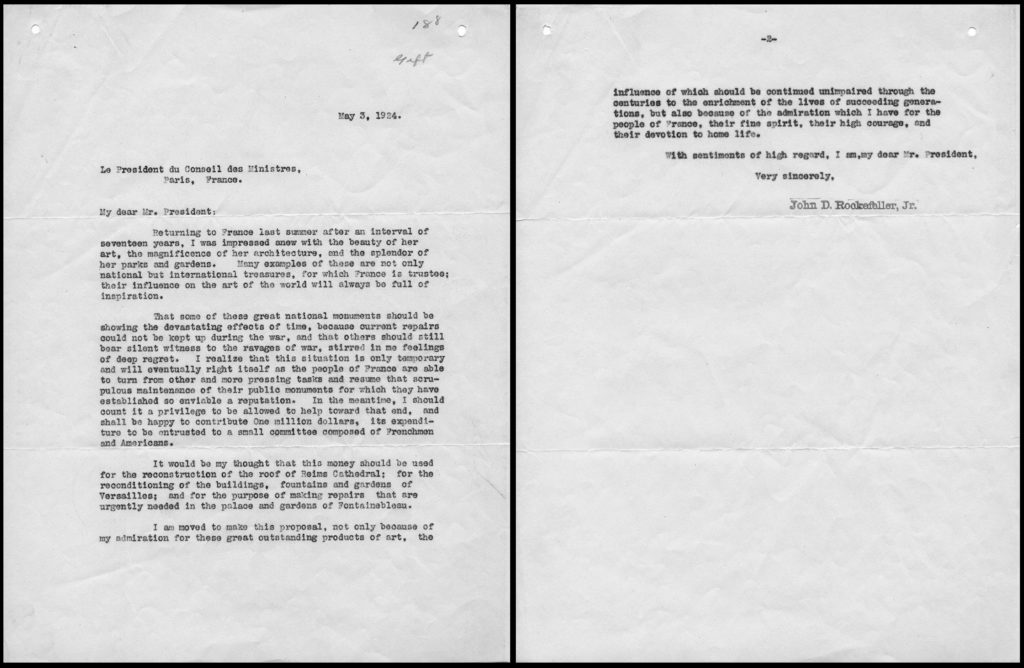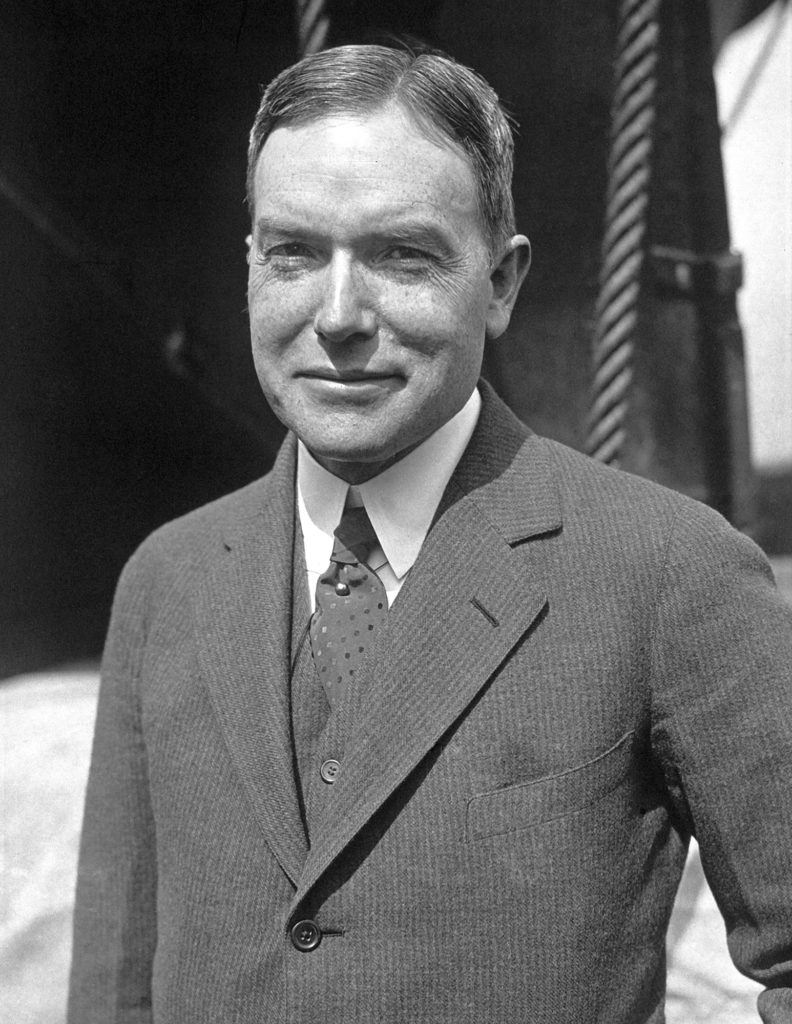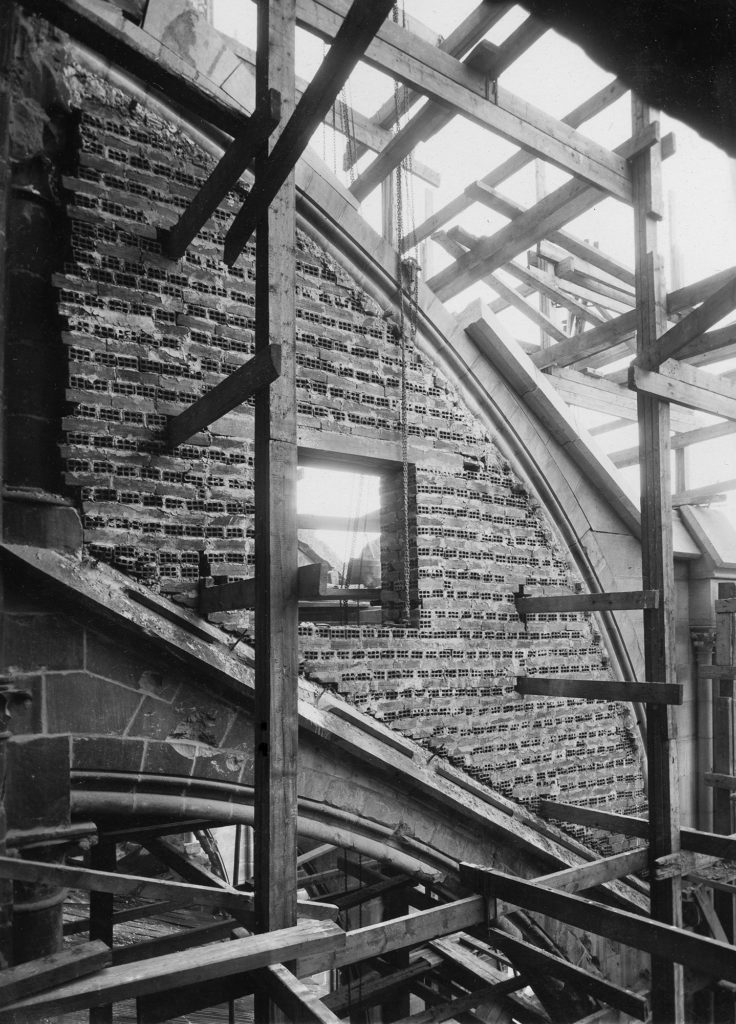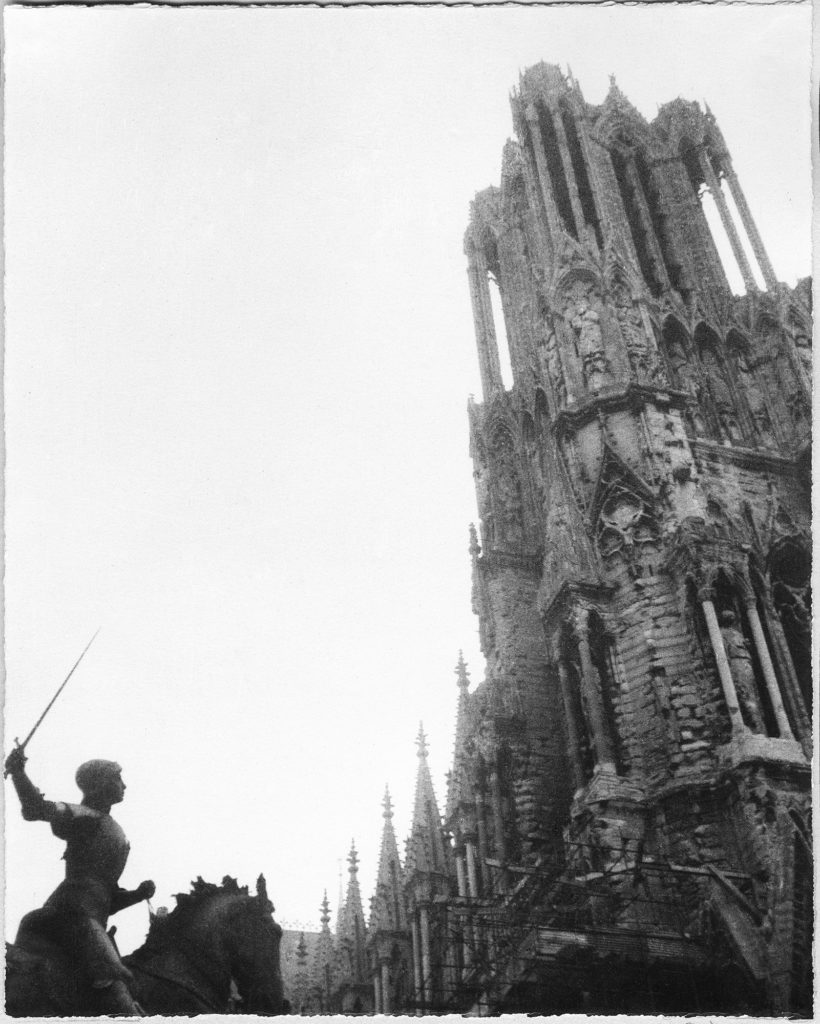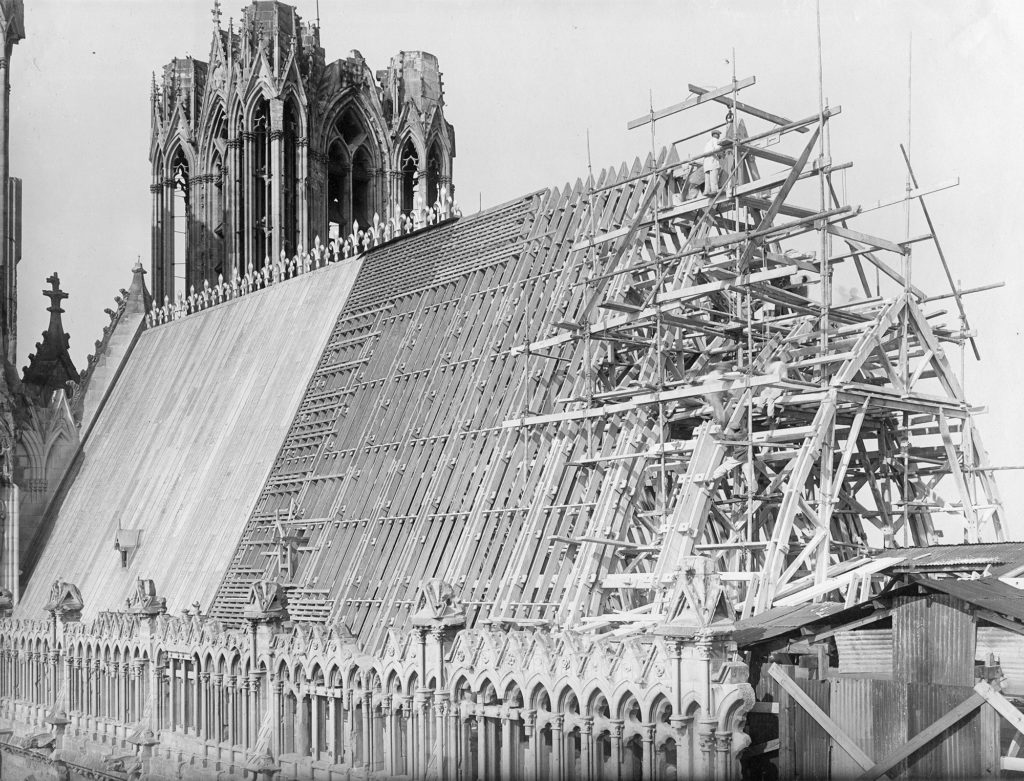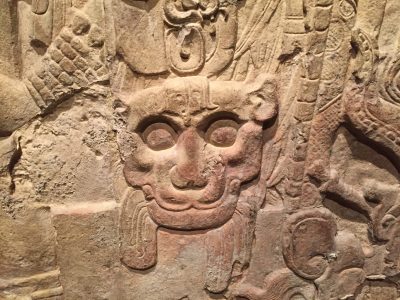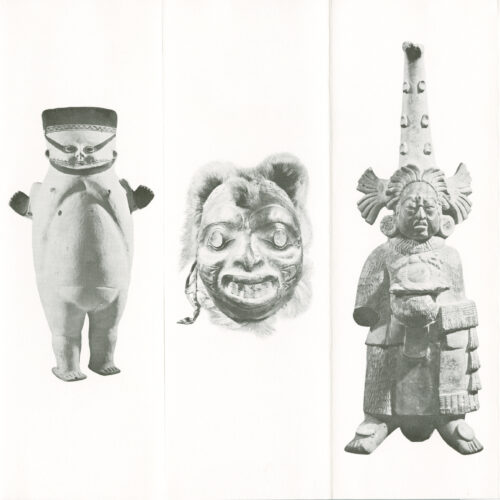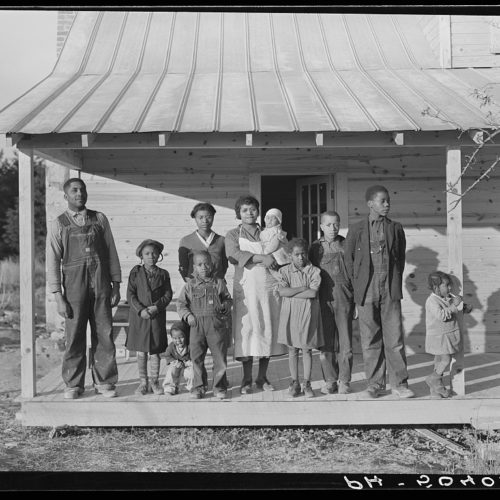On May 3, 1924, John D. Rockefeller, Jr., wrote to French Prime Minister Raymond Poincaré to make a formal offer of financial assistance for the restoration of several French national monuments. Preparations for Rockefeller’s gift, however, had been quietly in the works for months.
Rockefeller was concerned about the potential implications and pitfalls of this kind of international philanthropy. He knew that such a gift had to be managed carefully if he did not want to appear as a meddling outsider. With the help of his staff, Rockefeller consciously constructed a narrative about the donation that could reflect positively on all parties involved in the project.
The gift itself funded repairs at three separate sites: Reims Cathedral, the Palace of Versailles, and the Palace of Fontainebleau. But Rockefeller and his staff consistently emphasized that the most important of the three was the restoration of Reims Cathedral, a revered national symbol of the French people.
“The Ravages of War”
The Cathedral at Reims had sustained devastating damages during the First World War. On September 19, 1914, a German shell lit a ravaging fire that consumed the Cathedral, causing the roof to collapse and destroying the interior. While the palaces to be restored with Rockefeller’s gift were in disrepair due to “the devastating effects of time,” the Cathedral was a visible example of “the ravages of war” on humanity and culture.John D. Rockefeller, Jr. to Raymond Poincaré, May 3, 1924, French Restorations – Restorations in France – Gifts – Articles on Work, 1925-1933, Office of the Messrs. Rockefeller records, Cultural Interests, Series E, Rockefeller Archive Center.
“Profound Admiration” Inspires a Gift
It is difficult to pinpoint a single reason why John D. Rockefeller, Jr. decided to help restore French cultural monuments. Certainly the gift was consistent with family tradition. Even before he made his millions in the late nineteenth century, John D. Rockefeller, Sr. gave a significant percentage of his earnings to charitable causes. Established in 1913, the Rockefeller Foundation was the primary mechanism for carrying out Rockefeller’s organized philanthropy. It worked worldwide to support educational, medical, and public health initiatives.
The state of international politics following the First World War doubtless played a role in John D. Rockefeller, Jr.’s decision. Many reports about the gift cited Rockefeller’s discussions of “the question with friends of France” upon his return from a trip to that country in 1923.“Rockefeller Jr. Gives $1,000,000, Helps Restore Rheims Cathedral,” New York Evening World, May 30, 1924, French Restorations – Gift to France – Newspaper Articles and Booklets, 1924-1927, Office of the Messrs. Rockefeller records, Cultural Interests, Series E, Rockefeller Archive Center.Based upon his status and reputation, it is possible that Rockefeller was met with requests or perhaps even some pressure from French government officials or his American associates to make a donation.
With memories of the war and its conclusion fresh in American and European minds, many felt that the United States had the obligation, burden, or opportunity to continue to support its allies in the conflict. Newspaper articles with titles such as “America to the Rescue”“America to the Rescue,” New York Evening World, May 31, 1925, Folder 1244, French Restorations – Gift to France – Newspaper Articles and Booklets, 1924-1927, Office of the Messrs. Rockefeller records, Cultural Interests, Series E, Rockefeller Archive Center.and “Help Others Help Themselves”“Help Others Help Themselves,” The Richmond Palladium, June 3, 1924, Folder 1244, French Restorations – Gift to France – Newspaper Articles and Booklets, 1924-1927, Office of the Messrs. Rockefeller records, Cultural Interests, Series E, Rockefeller Archive Center.expressed a national public opinion that was generally favorable towards Rockefeller and, in most cases, sympathetic to the French.
Even considering these many outside influences, the simplest explanation behind Rockefeller’s gift might be his genuine affinity for a monument of such artistic and cultural significance. Rockefeller was a devoutly religious man with an aesthetic preference for medieval art and architecture. In a 1928 letter, Rockefeller described his “deep interest in the Cathedral and profound admiration for it.”John D. Rockefeller, Jr. to Georges Charbonneaux, September 14, 1928, French Restorations – Restorations in France, 1928-1939, Office of the Messrs. Rockefeller records, Cultural Interests, Series E, Rockefeller Archive Center.
Forming a Committee
Since Rockefeller knew that a contribution by a foreign philanthropist to a French national cause would be a delicate matter, he spent much time putting together a team of experts in related areas. The five men who were ultimately selected had experience in architecture, politics, and finance. Each one also had a vested interest in Franco-American relations.“M. Rockefeller donne un million de dollars pour Reims, Versailles, et Fontainebleau,” L’éclair (Paris), May 30, 1924, French Restorations – Gift to France – Newspaper Articles and Booklets, 1924-1927, Office of the Messrs. Rockefeller records, Cultural Interests, Series E, Rockefeller Archive Center.These men communicated with French officials privately and extensively to ensure all details were accounted for before the news was announced to the public.
Self-Consciously an Outsider
In an April 1924 letter to Colonel Arthur Woods, who assisted with the negotiations, Rockefeller expressed his public relations concerns. He sought to find a way to offer the gift in an appropriate and respectful way.
Many questions surrounded the donation. First, which governmental body should allocate the resources? Second, how would the Rockefeller donation work in conjunction with the funds already provided by French sources? And third, for which precisely defined purposes could the money be used?John D. Rockefeller, Jr., “Memorandum,” February 1924, French Restorations – Restorations in France, 1920-1927, Office of the Messrs. Rockefeller records, Cultural Interests, Series E, Rockefeller Archive Center.Rockefeller left many of the details up to his associates. However, on the point of limiting the amount of the original gift to one million dollars he was firm. He wrote, “any larger sum might, I fear, subject me to criticism.”John D. Rockefeller, Jr. to Arthur Woods, April 15, 1924, French Restorations – Restorations in France – Gifts – Articles on Work, 1925-1933, Office of the Messrs. Rockefeller records, Cultural Interests, Series E, Rockefeller Archive Center.
Helping, but not Offending
Although the aims of the project seemed honorable enough – to restore and protect a significant religious site with cultural and national importance – committee members knew that its motivations could be interpreted in many different ways and inadvertently cause offense to the American or French governments.
Committee members labored to frame the gift in such a way that they could refute the potential criticism. Official documentation underwent several draft stages before being released, with words chosen carefully to strike a conciliatory and impartial tone.John D. Rockefeller, Jr. to Raymond Poincaré, May 3, 1924, French Restorations – Restorations in France – Gifts – Articles on Work, 1925-1933, Office of the Messrs. Rockefeller records, Cultural Interests, Series E, Rockefeller Archive Center.; John D. Rockefeller, Jr. to Raymond Poincaré, May 3, 1924 (draft), French Restorations – Restorations in France – Gifts – Articles on Work, 1925-1933, Office of the Messrs. Rockefeller records, Cultural Interests, Series E, Rockefeller Archive Center.; John D. Rockefeller, Jr. to Raymond Poincaré, undated (draft), French Restorations – Comite Franco-Americain – Arthur Woods Correspondence, 1924-1927, Office of the Messrs. Rockefeller records, Cultural Interests, Series E, Rockefeller Archive Center.
The committee kept the entire project timeline in mind from the start. This included a second donation Rockefeller made in 1927 for additional restoration work.John D. Rockefeller, Jr. to Arthur Woods, March 19, 1927, French Restorations – Restorations in France – Gifts – 1927 Pledge, 1927, Office of the Messrs. Rockefeller records, Cultural Interests, Series E, Rockefeller Archive Center.In early private communications about his first gift, Rockefeller had hinted that “two or three or five years later a further sum [may] be added.”John D. Rockefeller, Jr. to Arthur Woods, April 15, 1924, French Restorations – Restorations in France – Gifts – Articles on Work, 1925-1933, Office of the Messrs. Rockefeller records, Cultural Interests, Series E, Rockefeller Archive Center. While the committee worked with this possibility in mind, members also recognized that an additional Rockefeller donation was only one of many potential paths that the project could follow. The group planned as if further support would not be coming from the donor.
[T]wo or three or five years later a further sum [may] be added.
John D. Rockefeller, Jr., April 15, 1924.John D. Rockefeller, Jr. to Arthur Woods, April 15, 1924, French Restorations – Restorations in France – Gifts – Articles on Work, 1925-1933, Office of the Messrs. Rockefeller records, Cultural Interests, Series E, Rockefeller Archive Center.
Confronting Questions About Optics
To be sure, John D. Rockefeller, Jr. committed to support all three historic sites. But to encourage a positive public opinion, the committee chose to focus its attention and communication on the restoration of Reims Cathedral, with only secondary mention of the Palaces of Versailles or Fontainebleau. This was done despite the fact that the greatest financial portion of the gift went to the repairs at Versailles. Rockefeller and his associates discussed the Cathedral first and foremost to reporters on both sides of the Atlantic.John D. Rockefeller, Jr. to Arthur Woods, April 15, 1924, French Restorations – Restorations in France – Gifts – Articles on Work, 1925-1933, Office of the Messrs. Rockefeller records, Cultural Interests, Series E, Rockefeller Archive Center.They did this to such an extent that, in some accounts, the palaces seem like an afterthought.
Restoring a National Symbol
Reims was so important to French history that it had long served as a national symbol even more so than a religious one. Traditional accounts trace the birth of the French nation itself to Clovis, the 5th century king and uniter of the Francs. Clovis was baptized at Reims, marking a definitive moment in defining France as its own nation.Euloge Boissonnade, Le Baptême de Clovis : Naissance de la Nation Française. (Paris: Godefroy de Bouillon, 1995).
Significantly, then, the damages to the Cathedral sustained during World War I were a national trauma. The German bombing struck a devastating chord. Postcards depicting the 1914 bombing are testament to the symbolic significance of the Reims Cathedral to the French national spirit.
On the other hand, the Versailles and Fontainebleau palaces were victims of long neglect, not wartime attacks. John D. Rockefeller, Jr. observed their disrepair during a visit in 1923, prompting his support of those restorations. Although important historical sites, the palaces recalled a gilded, monarchist past. In contrast, the Cathedral was a symbol of the nation as a whole.
Reims in the Headlines
Reports of the donation embraced this symbolic angle, putting emphasis on the Cathedral. A New York Evening World article of May 30, 1924 featured the headline, “Rockefeller Jr. Gives $1,000,000, Helps Restore Rheims Cathedral.” A smaller subtitle followed, announcing “$750,000 Will Be Used to Repair Palaces at Versailles and Fontainebleau.”“Rockefeller Jr. Gives $1,000,000, Helps Restore Rheims Cathedral,” New York Evening World, May 30, 1924, French Restorations – Gift to France – Newspaper Articles and Booklets, 1924-1927, Office of the Messrs. Rockefeller records, Cultural Interests, Series E, Rockefeller Archive Center.
The article makes only brief mention of the palaces, going into extensive details about the condition and needs of the Cathedral. Yet its final line concisely states, “[a]bout one-fourth of Mr. Rockefeller’s gift will be spent on the Cathedral.” In short, three quarters of the funding was spent on the projects least written about.“Rockefeller Jr. Gives $1,000,000, Helps Restore Rheims Cathedral,” New York Evening World, May 30, 1924, French Restorations – Gift to France – Newspaper Articles and Booklets, 1924-1927, Office of the Messrs. Rockefeller records, Cultural Interests, Series E, Rockefeller Archive Center.
The Public Verdict
Ultimately, the public response was indeed positive. Nevertheless, some voices of dissent emerged. For example, some Americans suggested that the money ought to be spent domestically. Others thought the Cathedral should be left untouched as a monument to the tragedy of war.“Not by Bread Alone,” Fort Myers, Florida News, May 31, 1927, French Restorations – Gift to France – Newspaper Articles and Booklets, 1924-1927, Office of the Messrs. Rockefeller records, Cultural Interests, Series E, Rockefeller Archive Center.; “Rheims – A War Memorial,” Post Dispatch (St. Louis, MO), May 31, 1924, French Restorations – Gift to France – Newspaper Articles and Booklets, 1924-1927, Office of the Messrs. Rockefeller records, Cultural Interests, Series E, Rockefeller Archive Center.
Most accounts celebrated the donation, reflecting the same unifying sentiments Rockefeller had expressed in his original letter to Poincaré: “such a structure as this great Cathedral belongs to the world, rather than to the country in which it happens to be situated.”“Reims, A World Monument,” Journal-Herald (Delaware, OH), June 4, 1924, French Restorations – Gift to France – Newspaper Articles and Booklets, 1924-1927, Office of the Messrs. Rockefeller records, Cultural Interests, Series E, Rockefeller Archive Center.
French government officials and citizens wrote publicly and privately to Rockefeller, expressing their thanks. In 1936, John D. Rockefeller, Jr., and his wife Abby were honored at a ceremony during their visit to Reims.John D. Rockefeller, Jr. to sons, July 11, 1936, French Restorations – Restorations in France – Committee to Supervise Expenditures of Gift, 1924-1940, Office of the Messrs. Rockefeller records, Cultural Interests, Series E, Rockefeller Archive Center.
Such a structure as this great Cathedral belongs to the world…
John D. Rockefeller, Jr. to French President Poincaré, 1924.“Reims, A World Monument,” Journal-Herald (Delaware, OH), June 4, 1924, French Restorations – Gift to France – Newspaper Articles and Booklets, 1924-1927, Office of the Messrs. Rockefeller records, Cultural Interests, Series E, Rockefeller Archive Center.
Further Support
Rockefeller’s early indications about a possible second gift were indeed realized in 1927. This new donation was made with just as much planning and discussion, albeit with less fanfare. This might be because of the modesty that Rockefeller and his associates had established in their philanthropic work. Timing may have also played a role: the announcement of the gift came just a few days after Charles Lindbergh’s historic transatlantic flight, which understandably dominated news headlines.“Rockefeller Touches the Heart of France,” State (Columbia, SC), May 30, 1927, French Restorations – Gift to France – Newspaper Articles and Booklets, 1924-1927, Office of the Messrs. Rockefeller records, Cultural Interests, Series E, Rockefeller Archive Center.
Rockefeller and his associates might have simply taken advantage of the third anniversary of the original donation to make the announcement of the second gift. But it is also possible that its concurrence with larger news events and its subsequently muted press coverage is another example of their planning strategy.
Indeed it was this level of careful consideration that enabled the building of a positive narrative around what the New York Times deemed a “nobly conceived and practically planned gift.”“The Rheims Restoration,” New York Times, May 31, [1924], French Restorations – Comite Franco-Americain – Arthur Woods Correspondence, 1924-1927, Office of the Messrs. Rockefeller records, Cultural Interests, Series E, Rockefeller Archive Center.
Research This Topic in the Archives
- “France – Reims – Civic Buildings before and after WWI,” 1875-1969 (Bulk: 1910-1969), 1910-1969, John D. Rockefeller Jr. papers, family photographs, Series 1005, Lantern Slides, Rockefeller Archive Center.
- “France – Reims – Reims Cathedral – Reconstruction,” 1875-1969 (Bulk: 1910-1969), 1910-1969, John D. Rockefeller Jr. papers, family photographs, Series 1005, Lantern Slides, Rockefeller Archive Center.
- “Reims Cathedral,” circa 1926, Rockefeller family papers, Audiovisual Materials, Home Movies and Newsreels, Audiovisual Materials, Home Movies and Newsreels, John D. Rockefeller Jr. Family Home Movies, Series 2, Rockefeller Archive Center.
- “French Restorations – Restorations in France,” 1920-1927, Office of the Messrs. Rockefeller records, Cultural Interests, Series E, French Restorations, Rockefeller Archive Center.
- “French Restorations – Restorations in France,” 1928-1939, Office of the Messrs. Rockefeller records, Cultural Interests, Series E, French Restorations, Rockefeller Archive Center.
- “French Restorations – Restorations in France – Jusserand,” 1924-1929, Office of the Messrs. Rockefeller records, Cultural Interests, Series E, French Restorations, Rockefeller Archive Center.
- “French Restorations – Restorations in France – Committee to Supervise Expenditures of Gift,” 1924-1940, Office of the Messrs. Rockefeller records, Cultural Interests, Series E, French Restorations, Rockefeller Archive Center.
- “French Restorations – Restorations in France – Welles Bosworth Correspondence,” 1936-1958, Office of the Messrs. Rockefeller records, Cultural Interests, Series E, French Restorations, Rockefeller Archive Center.
- “French Restorations – Restorations in France – Gifts – H. F. Sheets,” 1923-1936, Office of the Messrs. Rockefeller records, Cultural Interests, Series E, French Restorations, Rockefeller Archive Center.
- “French Restorations – Restorations in France – Gifts – Articles on Work,” 1925-1933, Office of the Messrs. Rockefeller records, Cultural Interests, Series E, French Restorations, Rockefeller Archive Center.
- “French Restorations – Comite Franco-Americain – Arthur Woods Correspondence,” 1924-1927, Office of the Messrs. Rockefeller records, Cultural Interests, Series E, French Restorations, Rockefeller Archive Center.
- “French Restorations – Comite Franco-Americain – Equitable Trust Company, Chase,” 1924-1936, Office of the Messrs. Rockefeller records, Cultural Interests, Series E, French Restorations, Rockefeller Archive Center.
Related
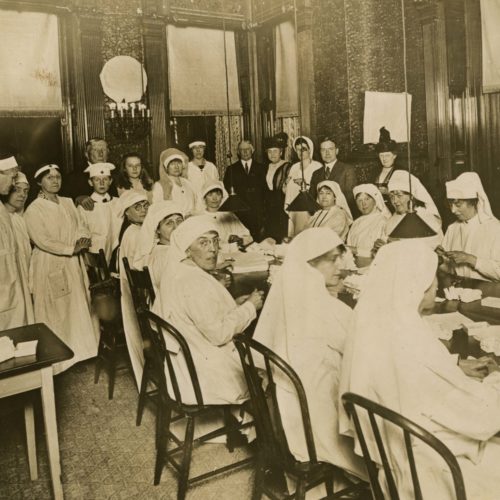
Timeline: Philanthropy and World War I
The onset of World War I created new demands on American foundations and donors.
